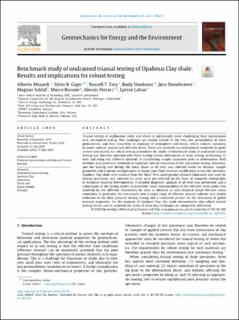| dc.contributor.author | Minardi, Alberto | |
| dc.contributor.author | Giger, Silvio B. | |
| dc.contributor.author | Ewy, Russel T. | |
| dc.contributor.author | Stancovic, Rudy | |
| dc.contributor.author | Stenebråten, Jørn | |
| dc.contributor.author | Soldal, Magnus | |
| dc.contributor.author | Rosone, Marco | |
| dc.contributor.author | Ferrari, Alessio | |
| dc.contributor.author | Laloui, Lyesse | |
| dc.date.accessioned | 2020-12-07T13:39:03Z | |
| dc.date.available | 2020-12-07T13:39:03Z | |
| dc.date.created | 2020-08-13T20:27:20Z | |
| dc.date.issued | 2020 | |
| dc.identifier.citation | Geomechanics for Energy and the Environment. 2020, 25 . | en_US |
| dc.identifier.issn | 2352-3808 | |
| dc.identifier.uri | https://hdl.handle.net/11250/2712220 | |
| dc.description.abstract | Triaxial testing of argillaceous rocks and shales is significantly more challenging than conventional rock mechanical testing. The challenges are mainly related to the very low permeability of these geomaterials, and their sensitivity to exposure of atmosphere and brines, which induces variations of water content, suction and effective stress. There are currently no international standards to guide service laboratories for robust testing procedures for shales. A benchmark study of undrained triaxial testing was therefore initiated with three leading service laboratories in shale testing, performing 13 tests and using two different methods of establishing sample saturation prior to deformation. Both methods paid particular attention to minimize volume expansion of the specimens during saturation, and the loading rate during the shear phase in all tests was selected based on intrinsic sample properties and drainage configurations to ensure pore fluid pressure equilibration across the specimen. Opalinus Clay shale core material from the Mont Terri underground research laboratory was used for testing specimens, and intervals on cores were pre-selected on the basis of computer tomography to minimize material heterogeneity. A detailed diagnostic analysis of all tests was performed, and a comparison of the testing results is presented. Good reproducibility of the effective stress paths was achieved by the different laboratories for tests at identical or near-identical initial effective stress conditions. In particular, the test results over a larger range of effective stresses indicate very similar evolution of the fluid pressure during testing and a consistent picture for the derivation of global material properties. On the example of Opalinus Clay, the study demonstrates that robust triaxial testing results can be achieved for shales if some key challenges are adequately addressed. | en_US |
| dc.language.iso | eng | en_US |
| dc.publisher | Elsevier | en_US |
| dc.rights | Attribution-NonCommercial-NoDerivatives 4.0 Internasjonal | * |
| dc.rights.uri | http://creativecommons.org/licenses/by-nc-nd/4.0/deed.no | * |
| dc.subject | Strength | en_US |
| dc.subject | Elastic moduli | en_US |
| dc.subject | Strain rate | en_US |
| dc.subject | Saturation | en_US |
| dc.subject | Opalinus Clay | en_US |
| dc.subject | Undrained triaxial testing | en_US |
| dc.title | Benchmark study of undrained triaxial testing of Opalinus Clay shale: Results and implications for robust testing | en_US |
| dc.type | Peer reviewed | en_US |
| dc.type | Journal article | en_US |
| dc.description.version | publishedVersion | en_US |
| dc.rights.holder | ©2020 The Authors. Published by Elsevier Ltd. This is an open access article under the CC BY-NC-ND license (http://creativecommons.org/licenses/by-nc-nd/4.0/). | en_US |
| dc.source.pagenumber | 17 | en_US |
| dc.source.volume | 25 | en_US |
| dc.source.journal | Geomechanics for Energy and the Environment | en_US |
| dc.identifier.doi | 10.1016/j.gete.2020.100210 | |
| dc.identifier.cristin | 1823246 | |
| dc.source.articlenumber | 100210 | en_US |
| cristin.ispublished | true | |
| cristin.fulltext | original | |
| cristin.qualitycode | 1 | |

